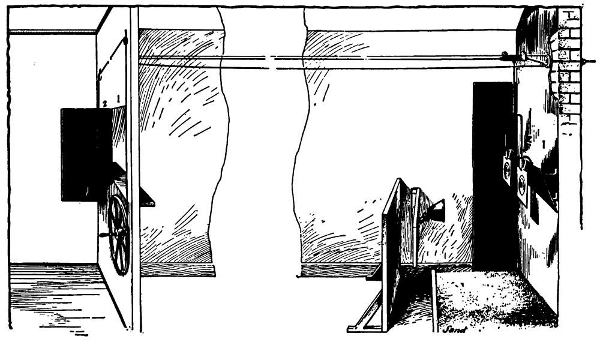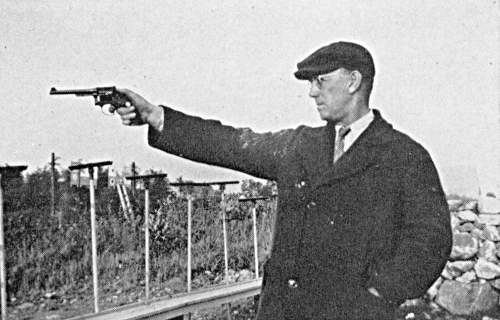The following information on revolver and pistol clubs comes from Burning Powder by Lt. Col. Douglas B. Wesson. Burning Powder is also available to purchase in print.
Although the Hand-Arm has long been an essential part of the soldiers’ and peace officers’ equipment and carried by countless thousands of civilians in dangerous localities, and there are a constantly increasing number of stories of the skill with which these arms were used, it was not actually until the last few years that revolver and pistol shooting really developed to anything approaching its possibilities. The revolver and pistol clubs that for many years struggled for existence, depending on a few genuine enthusiasts and recruiting but few new members, now have waiting lists, and new clubs are being formed in ever increasing numbers.
The organization of a club is simple, but should be carried on with utmost care. It should have as President an enthusiastic shooter and one whose personal integrity and standing in the community is beyond question; its Secretary and its Treasurer (or the two offices may be combined) must be not only enthusiastic, but absolutely painstaking in his attention to the details of records and financial affairs, for nothing is of greater importance in the conduct of club affairs than prompt and accurate reports of its activities. The selection of the Executive Officer, or Shooting Director, is of importance as it is upon his ability to not only successfully instruct in shooting, but to maintain the interest of the members, that the success or failure of the club depends. A publicity manager who can get the daily papers to carry accurate and interesting accounts of the club matches and social events will be most valuable in maintaining the interest of the members.
In these days of more and more restrictive firearms laws, it is essential that a Membership Committee be selected with utmost care. It is the duty of this Committee to investigate each applicant with a view to determining his fitness to receive from the local police, or other proper authority, a permit to purchase and carry a revolver or pistol. In many clubs this is carried out so successfully that the mere fact that an individual has been elected to the shooting club is sufficient guarantee of that man’s character to allow him to obtain a permit without further investigation.
The Secretary-Treasurer of the United States Revolver Association, whose address is 5 Oak Street, Springfield, Massachusetts, and the National Rifle Association, Barr Building, Washington, D.C., stand ready at all times to give all information on the matter of matches to shooting clubs and to render assistance of all kinds. The United States Revolver Association sponsors the Indoor and Outdoor Championship Matches and the U.S.R.A. Indoor and Outdoor League Matches, which continue practically throughout the summer and winter seasons. During the last Indoor Season the League had competing 115 teams, representing 75 Clubs.
The National Rifle Association is very active in the various police matches held throughout the country at frequent intervals, and at many of which civilian teams and individual shooters are welcome. The National Matches held at Camp Perry, Ohio, in the late summer of each year are the most hotly contested of all in the shooters’ calendar. Here teams and individual shooters meet from all parts of the United States and Territories vying for the highest honors in rifle and hand-gun shooting. Every man who really loves the game owes it to himself to make at least one trip to Perry; he surely will go back again. Full information can be obtained by writing to the Director of Civilian Marksmanship, Washington, D.C. Both the U.S.R.A. and N.R.A. are represented at these matches.
It goes almost without saying that Smith & Wesson is glad to be of any possible assistance to Revolver and Pistol Clubs and to give them the benefit of their experience and facilities. To further encourage the shooting game they offer a liberal discount from their retail prices to members of either of the Associations mentioned above who desire to buy either Military or Target arms. It is well to add that we allow no discounts to shooters who are not members of these organizations, or to local clubs, regardless of their size.
Range
The first point arising in the formation of a club is, of course, a suitable location for the range. The only requisite for the indoor range is about 85 feet in the clear, or 60 feet in the clear, if the 25 yard Military and Police Revolver Matches are not to be conducted; the 60 foot range is the distance at which the United States Revolver Association Indoor Matches are shot indoors. In the appendix will be found the listing of the various ranges and targets used in accepted matches.

After a suitable location has been found, the question of complete protection is paramount, and a minimum amount of plate is that necessary to fully cover the end of the range. Any reasonably heavy boiler plate is sufficient for the small calibre bullets, but as there are many large calibre enthusiasts who, at the approach of the outdoor season, will wish to practice with these arms, it will be necessary to use judgment in selecting the proper thickness of this material. Actual firing should be done to test the plate selected, using the heaviest calibre and load obtainable. Should the plate dent badly, although not puncturing, it should be rejected as these dents may readily cause a ricochet that might badly injure one on the firing line.
Proper lighting actually represents a far more important detail than would be imagined until the question is carefully investigated. At the Springfield Revolver Club all forms of lighting were thoroughly investigated, with most interesting conditions being discovered. A most common fault is over-illumination, frequently from above, with the result that the light rays not only tend to interfere with proper vision if there should be even a slight amount of smoke or dust in the air in the neighborhood of the target, but also the reflected light from the target causes an undue strain upon the shooter’s eyes. A light projected from slightly below the line of fire at a distance of about 4 feet, using a 40 watt Mazda lamp and a 45 degree aluminum reflector, with one lamp for each target, has worked out very satisfactorily indeed. As this is being written the Springfield Club is experimenting with daylight lighting in an attempt to duplicate the conditions that are met in outdoor shooting; if it can be successfully accomplished we can expect the indoor scores to reach even a higher level than at present. With this lighting it is planned to try out a buff or cream background, but this is highly experimental. The entire range should be painted with a flat dark green, and the shield ahead of the lights the same color. In recent years a buff, or dark cream target has become very popular, due to the fact that this color reflects less light than the white target commonly used, but with the lighting as described, this is not necessary.
Finances
While, of course, dues are essential, it is well to keep them at the lowest possible point; a small charge for targets, an occasional sweepstake with a “kitty” for the club, together with the salvage from the fired cases and lead will help greatly in the expense account.

of Winchester, Massachusetts with his K-.22. A good example of relaxation. Mr. Winn with the S&W K-.22 established the present 50 yard 50 shot “Any Revolver” record of 483×500 as well as the indoor 20 yard 50 shot record of 488×500.
The Executive Officer
The responsibilities of the Executive Officer, or Shooting Instructor are great; upon him is the responsibility for instructions in the proper handling of all arms, the general training of the Novices, and, the writer believes firmly, it is he who should have the selection of the teams and the order in which they shoot in contests.
The selection of this officer should not be made purely upon his shooting ability, as it frequently occurs that a most excellent shot is totally lacking in the ability to instruct others in the art. In this sport, as in many others, it is noticeable that the most successful Coaches are seldom outstanding performers, due to the very fact that their lack of success in high scoring has resulted in their making a close analysis of their own faults, and thus more readily recognizing the difficulties of others.
Safety
Nothing will more quickly get a shooting organization into ill-favor in the eyes of the public than an accident with firearms, and for that reason alone, to say nothing of the feelings of the victim, it is necessary that there be enforced a few simple but vital rules, the violation of which should result in the suspension, or expulsion of the member breaking any of them.
Safety First and Always
The first and most important of these rules must be “No Loaded Arms Except at the Firing Point.”
In our estimation it is well to have another rule requiring that all arms not at the firing point remain unclosed. This will, of course, prevent the very common practice of “dry shooting” or “snapping,” but it is obvious that it will also remove any possibility of an accidental discharge. It might be well to reserve a certain portion of the available space in the Clubroom for this practice with suitable aiming points.
